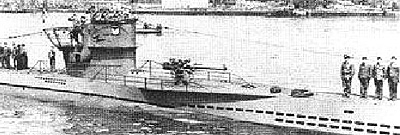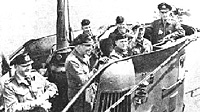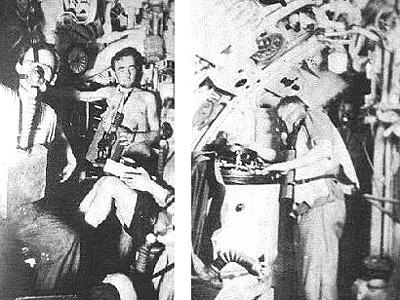 Here is the letter we recently received from Dr. HIGGINS, former SM 3/c USN Armed Guard:
Here is the letter we recently received from Dr. HIGGINS, former SM 3/c USN Armed Guard:
- “Thanks for your interest in my story about U-73. I did not research and write this out of any great admiration for the German U-Boat Service, but rather out of curiosity on my part about the people who almost made me a statistic on the wrong side of the ledger. Until the 90’s very little information was available regarding the extent of the U-Boat depredations, so for years I was in the dark about the men who had torpedoed my ship. Perhaps some of my old shipmates can have their curiosity satisfied and other old sailors will find out who it was who torpedoed their vessels.”
U-73 returning to her homeport at Lorient. If you have good eyes, you can see the crest of the city of Duisberg on her conning tower. She was adopted by that city in the war.
“Old Sledge”
This is a story, a chronicle if you will, of one of Hitler’s U-Boats; U-73 specifically. She was one of the 1167 U-Boats commissioned by the German Navy between 1925 and 1945; just one of the 757 U-Boats sunk by allied forces; a mortality rate suffered by no other service. U-73 was a type VII boat, the most numerous type built, over 640 of this class being constructed….the VIIC being the most numerous variant of this model.
At 760 tons displacement, she was roughly half the tonnage of the U.S. Fleet submarines, but was more maneuverable and could dive faster than the larger U.S. Fleet subs. With a length of 220 feet and a beam of 20 feet she was not very large for the area of the ocean where she served. With two 2800 h.p. diesel engines she could attain a speed of about 17.5 knots surfaced but could only make 7 to 8 knots submerged on the two 750 h.p. battery powered motors. Based on a design of a WWI submarine, Admiral Dönitz considered the class capable of achieving his expectations.
 As U-73 returns to Lorient, her Skipper Rosenbaum (in white hat) salutes.
As U-73 returns to Lorient, her Skipper Rosenbaum (in white hat) salutes.
The 113 tons of fuel carried aboard gave her a range of 6500 miles at 12 knots but submerged she could only make about 80 miles before her batteries gave out. Although designed for an operational depth of 394 feet, she had a rated crush depth of 656 feet; a depth which was exceeded many times throughout the war in efforts to escape from angry escorts.
The type VII normally carried four officers and forty six men but this number varied from boat to boat. When leaving on patrol the VII’s carried fourteen 21 inch torpedoes, four in the bow tubes and one in the stern tube, the remainder being carried in the forward and rear torpedo rooms and in storage areas beneath the deck plates.
On deck, the U-73 carried an 88mm gun, however not the same famed “88” of he panzer divisions; plus one 20mm cannon on the bridge. The 88mm gun was later replaced by a 40mm anti aircraft gun, plus additional 20mm guns were added when R.A.F. coastal command planes began harassing U-Boats crossing the Bay of Biscay. On her conning tower she wore the coat of arms of the city of Duisberg, which city had adopted her.
Life for the crew on a type VII was not very pleasant especially at the beginning of a patrol when every available space was filled with cans and boxes of food and supplies. The bunks in the forward and rear torpedo rooms were shared or “hot bunked” as the saying goes. There were only two heads on board, one of which was usually crammed with supplies, there were no hot showers or washing facilities and as a result beards were very much in evidence on board.
- EDITOR NOTE – the bunks were folded out of the way and torpedoes were slung in their place. Bunks were folded down after the torpedoes had been fired.
By the end of a patrol the constant stench of diesel oil, battery acids, cooking odors and unwashed bodies made the boats smell like pigpens, conditions which would have been intolerable on U.S. boats. The officers fared a little better, having the luxury of their own curtained off bunk and fresh, not salty, warm water to wash with. The origin of her nickname “Old Sledge” escapes me. Perhaps it was an affectionate or derisive pet name, much as we used to dub our ships as the “Old Bucket of Bolts”.
 Ordered 2 June 1938, the U-73 was laid down 5 November 1939 at the Bremer Vulcan yards in Vegesack, Germany. At this time her future captain, plus chief engineer and several of the important petty officers were assigned to her. This gave them the opportunity to become very familiar with all the features of the boat. Her captain, 32 years of age, (LCDR) Kapitänleutnant Helmut Rosenbaum was born in Dobein Germany on 10 May 1913, entered the navy in the class of 1932 and opted for submarine service.
Ordered 2 June 1938, the U-73 was laid down 5 November 1939 at the Bremer Vulcan yards in Vegesack, Germany. At this time her future captain, plus chief engineer and several of the important petty officers were assigned to her. This gave them the opportunity to become very familiar with all the features of the boat. Her captain, 32 years of age, (LCDR) Kapitänleutnant Helmut Rosenbaum was born in Dobein Germany on 10 May 1913, entered the navy in the class of 1932 and opted for submarine service.
Rosenbaum
Although Germany had been forbidden by the Treaty of Versailles to have submarines; under the ruse of building submarines for other countries such as Spain and Holland, Germany had secretly been building up a cadre of U-Boat personnel since 1922.
Captain Rosenbaum was well trained, having seen duty aboard U-35, U-27, U-31, U-26 and had been captain of U-2 prior to being assigned to U-73. Following her commissioning on 30 Sept. 1940 U-73 spent the next few months working up in the Baltic and was assigned to the 7th U-boat flotilla.
On 2 February 1941, U-73 left Helgoland on her first patrol. Because of increased air activity by British planes, a good deal of the daylight hours were spent submerged; surfacing at night to make up time in getting to her assigned position in the North Atlantic. Making contact with outgoing Convoy #228, Captain Rosenbaum tailed the convoy, reporting the position to Admiral Dönitz’s headquarters as was customary for all U-Boats when sighting a convoy. U-73 then attacked and sunk a 4260 ton ship, the SS Wingate on 24 February 1941. The U-73 then returned to her new base at Lorient on 3 March 1941.
 Left: Electro-obermaschinist inspecting the gyrocompass in the Zentralle (central control room).
Left: Electro-obermaschinist inspecting the gyrocompass in the Zentralle (central control room).
Right: Rosenbaum in the re-breather. Diesel Mechanic Erich Schmidt, to his left, was killed 16 December 1943.
On 25 March 1941 the U-73 left Lorient on her second patrol. On 3 April 1941 she sighted and attacked slow convoy #26, comprising 22 ships in the North Atlantic between Iceland and Scotland. The SS Indien (5409 tons) and the SS British Viscount (6895 tons) fell victims to her torpedoes. On 20 April, U-73 added SS Empire Endurance (8570 tons) to her bag bringing the total to four ships and 25,148 tons. She then returned to St. Nazaire on 24 April 1941.
U-73 left St. Nazaire on 20 May 1941 on her third patrol. At this time the monumentous battle between HMS Hood and Bismarck was about to unfold. When the Hood was blown up on 24 May 1940, a damaged Bismarck, leaking oil, vainly tried to evade British forces which sought to avenge the loss of the Hood. The Bismarck headed for the Bay of Biscay in an attempt to reach the safety of the French Channel Ports but was discovered and attacked by British surface forces and torpedo bombers. Pounded to a flaming shambles, unable to steer or fire her guns any longer, the Bismarck was then given the Coup de grace by torpedoes from HMS Dorsetshire.
(This is a well researched and long piece. Continued in KTB #182 next month. )
Back to KTB # 181 Table of Contents
Back to KTB List of Issues
Back to MagWeb Master Magazine List
© Copyright 2004 by Harry Cooper, Sharkhunters International, Inc.
This article appears in MagWeb.com (Magazine Web) on the Internet World Wide Web. Other articles from military history and related magazines are available at http://www.magweb.com
Join Sharkhunters International, Inc.: PO Box 1539, Hernando, FL 34442, ph: 352-637-2917, fax: 352-637-6289, www.sharkhunters.com
